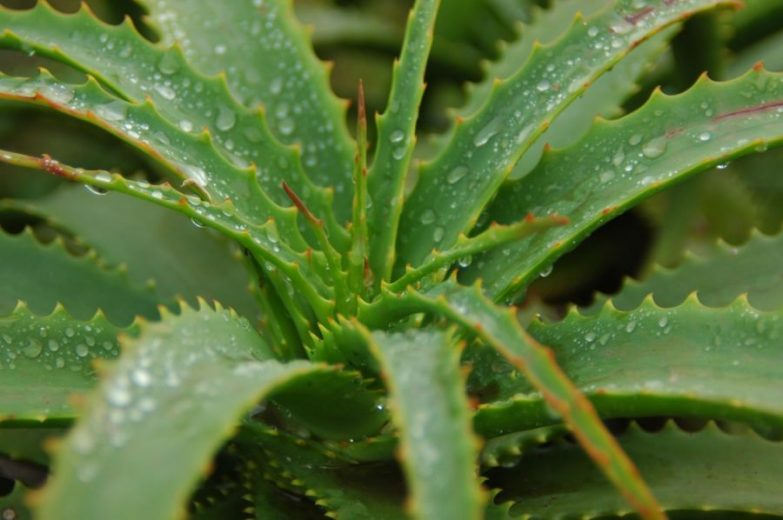Aloe vera plants are not hard to grow, but they do have a few special needs that require attention. If these needs aren’t met, you may find your aloe vera plant turning brown.
Thankfully, it’s not too hard to identify the problem and get your plant back in good health. This article is going to explain the common causes of an aloe vera plant turning brown, show you how to identify them and help you fix your plant.
Why Is Your Aloe Vera Plant Turning Brown?
The most common reasons for an aloe vera plant turning brown are the following;
- Overwatering
- Underwatering
- Excessive Heat
- Drafts or Cold Air
- Sunburn
- Too much fertilizer
- Pests
- Diseases
- Plant damage
Keep reading as I discuss each cause, in turn, to help you save your aloe vera plant and prevent these problems from recurring. Check out my book, Houseplants Made Easy for a complete guide to keeping all your houseplants healthy.
Is Your Aloe Vera Plant Turning Brown Due To Overwatering?
If your aloe vera plant is being overwatered, you’ll first start to see spots appearing on the leaves that look sort of wet and soggy. Eventually, the soggy spots will spread, and the entire leaf will begin to look soggy and then turn brown.
If this problem is not taken care of quickly, the leaves will fall off and the plant will die. Your plant may also suffer from root rot, which is a condition in which the roots begin to rot and decay from sitting in too much water for too long.
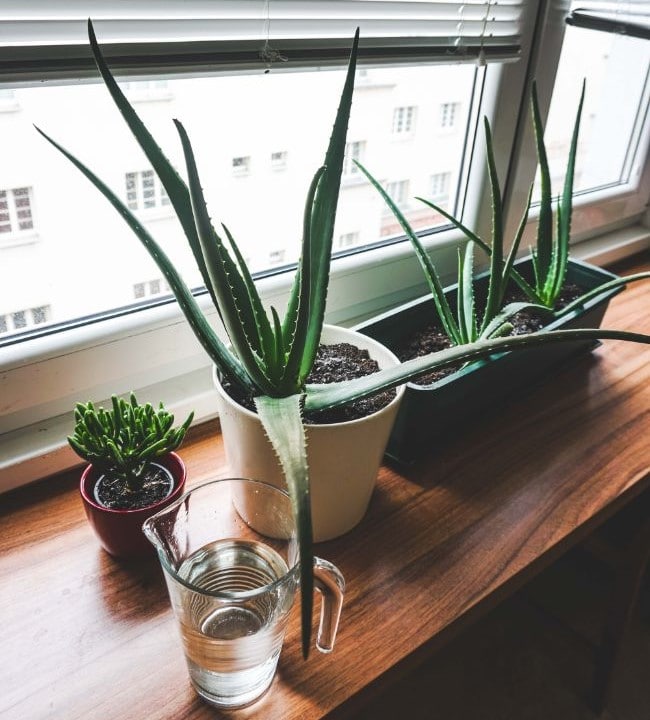
Repot And Reduce Watering
To save your aloe plant from overwatering, you’ll need to repot it right away. Gently turn the plant and pot on its side on a hard surface, and carefully slide the plant out of the pot. You’ll want to brush away the soggy dirt as much as possible while being careful not to damage any fragile roots.
If any of the roots are rotting or mushy, you’ll need to remove them with a pair of sharp, clean shears. Avoid removing any healthy roots. Replace the wet soil in the pot with fresh soil and gently replant your aloe.
Root rot and brown spots may also be a sign that your aloe plant has been planted in an inappropriate soil medium. When repotting, you may want to try a commercial cactus and succulent soil, or use a potting soil mixed with plenty of perlite to provide good drainage.
You may want to use a different pot when repotting your aloe plant, as well. A pot that is plastic or metal will hold in more water, while a pot that is clay or terra cotta will dry out more quickly.
Most succulents will grow better in a terracotta pot than a plastic one since they wick away moisture more quickly. Make sure that you always use a pot with drainage holes. If there is a decorative wrap on your plant’s pot, remove that so the soil can drain more freely.
Water your aloe plant much less often. Make sure that it completely dries out in between waterings, and don’t let the water sit on the roots or the plant. You should not need to water your plant more than once per week and even less in the winter season when it is dormant.
For more information on when to water your plants to prevent overwatering, read this article.
Is Your Aloe Vera Plant Turning Brown Due To Underwatering?
Generally speaking, it is better to under-water succulent plants than it is to overwater them. However, if you are seeing brown leaf tips on your aloe vera plant, this is an indication that it isn’t receiving enough water.
Over time, the leaves will thicken and harden and the brown tips will begin to spread down the length of the plant. Your aloe plant’s leaves may look shrivelled and shrunken.
Water Your Aloe When The Soil Is Dry
Remember to water your aloe plant when the soil is dry. Give it a thorough and complete watering until the water runs out of the drain hole at the bottom of the pot. This should be enough water to keep your aloe plant healthy and thriving.
Allow all of the excess water to run out of the pot, and then do not water your plant again until the soil has become dry. If your aloe plant needs more frequent watering than it normally would, you may need to look at temperature, humidity, and amount of light to determine if there are other issues causing problems for your plant in addition to infrequent watering.
Is Your Aloe Vera Plant Turning Brown Due To Excessive Heat?
Aloe vera plants can easily become shocked by sudden temperature changes and extreme heat. If you move your aloe plant from indoors to outdoors in the summer, you may notice that the leaves begin to turn brown from the shock of sudden exposure to heat.
Even though aloe plants are desert natives, they do best between 55-80°F. Higher temperatures, especially for prolonged periods, can be damaging to your aloe plant. It may also dry out too quickly or become sunburned, complicating the problem.
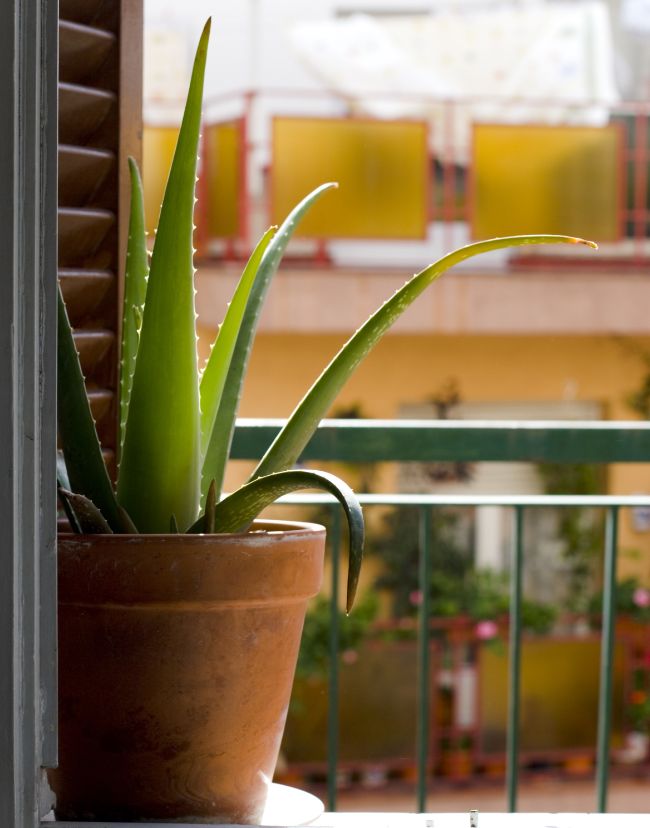
Acclimate Your Aloe Plant To The Outdoors
To avoid shock or heat damage, you’ll need to slowly acclimate your aloe to the outdoor temperatures. Move it to a shady and cooler location at first to give it time to adjust to the outdoor setting. Gradually acclimate your plant to warmer or brighter locations, starting a few hours at a time.
Summer heat might still be too much for your aloe plant and direct sunlight may cause it to burn.If you find the outdoors is too much for your aloe, simply bring it back inside and allow it to become healthy again.
Is Your Aloe Vera Plant Turning Brown Due To Drafts Or Cold Air?
If your aloe is suffering from cold shock, the leaves will begin to droop and turn yellow. Eventually, brown will travel down the leaves towards the base of the plant. The leaves closest to the cold source will be lost first. If left untreated, the entire plant will die from the cold or from cold shock.
Keep Aloe Plants Warm
Aloe plants are most comfortable around the same temperature as people – between 55-80°F. If the temperatures drop below 55°F, or if they change suddenly, your aloe plant might get too cold or go into shock.
Keep your aloe plant warm! You’ll want to keep it in temperatures above 55°F as well as keep it away from sudden, cold drafts of air.
Keep your aloe plant away from air conditioners, fans, windows, and anywhere cold drafts might come in contact with your plant. You’ll want to keep your aloe away from any exterior doors during the fall and winter when cold drafts happen frequently. A little protection will go a long way in keep your plant healthy.
If you live in a growing zone where aloe plants can overwinter outdoors, you’ll want to put some straw or other insulation around the base of your plant to keep it from freezing in the cold.
Is Your Aloe Vera Turning Brown Due To Sunburn?
Although aloe plants are often used to treat sunburn, they can be very susceptible to sunburn themselves. An aloe vera plant that is getting sunburned will start turning red or brown, starting at the tips due to inhibition of photosynthesis. The leaves of the plant may turn into a faded green color or they may develop brown spots on the leaves, sometimes called sunspots.
You may also notice it needs to be watered more than once a week because the soil is drying out too quickly. These are signs that your plant is suffering from too much direct sun, resulting in sunburn.
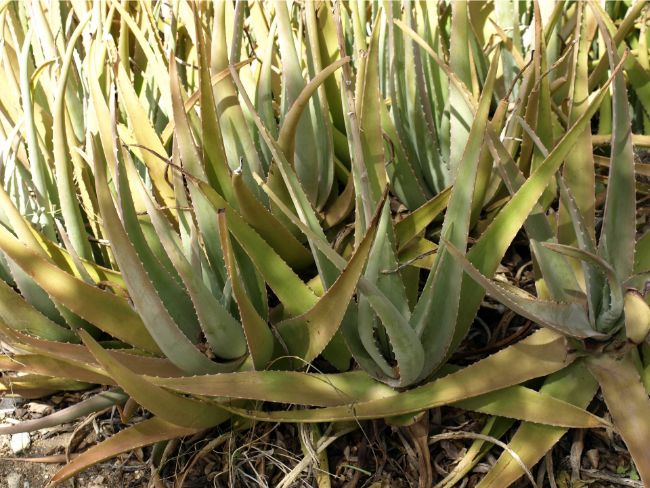
Keep Aloe Plants Out Of Direct Sun
If you think your aloe plant is experiencing sunburn, immediately remove it from the direct sunlight. If it is outside, you may need to move it into the shade or you may want to bring it back inside.
If your plant is getting sunburned because it is located in a window with direct sunlight, you will need to move it further from the light source. Consider moving your plant to a window on the opposite side of the house.
Once you’ve moved your aloe plant away from too much direct sunlight, you’ll want to make sure your aloe is getting enough water. The extra sunlight might be drying it out too quickly and adding to the problem. Watering appropriately will help your aloe plant recover more quickly.
Is Your Aloe Vera Turning Brown Due To Too Much Fertilizer?
Aloe vera plants don’t need much in the way of fertilizer. Too much fertilizer will cause chemical salts to build up in the soil, burning the roots. The damage to the roots will begin to show as the leaves begin to brown.
Flush the Soil and Fertilize Aloe Plants Sparingly
You can save your aloe plant by drenching the soil to wash away some of the fertilizer. Set your potted aloe plant in your sink or outside and flush the soil thoroughly for several minutes.
Allow all of the extra water to drain out of the pot. This will wash away the fertilizer build up in the soil. Don’t water again until the soil completely dries out.
Do not over fertilize your aloe plant. They simply don’t need it. Only fertilize once per year in the spring with half strength succulent fertilizer. If your potting soil has fertilizer already mixed in, you will not need to fertilize your plant at all for several years.
Is Your Aloe Vera Turning Brown Due To Pests?
We think of aloe plants as being very hardy and not really subject to pests or disease. But the truth is, aloe vera can be subject to several types of pests which can damage the plant and cause brown spots to appear on the leaves.
Mites, flies, mealybugs, and fungus gnats can cause issues for your aloe plant. This damage can be unsightly and worse yet, it can be lethal to the plant.
Fight Pests
You can prune away any severely infected or sick leaves with a pair of shears or sharp scissors. After you do this, figure out what kind of pest is infecting your plant and treat accordingly to solve the problem.
Mealybugs pierce the plant and suck out the sap. This causes stunted and uneven growth. Left untreated, the plant will begin to turn yellow and then brown. Over time, a mealybug infestation can be fatal for the plant.
Mealybugs, as well as flies, can be washed off with a steady stream of water.Allow the plant to dry off so that the moisture does not inflict any additional damage to the plant.
Mites, on the other hand, cause irreversible damage to the growth of the plant. If you act quickly, you may be able to save the plant with a commercial miticide from the garden center. If this does not kill the mites, you may need to dispose of the plant altogether.
Keep the infected plant away from any other houseplants, especially other aloe plants, so that the infestation does not travel to any other plants and do more damage.
Fungus gnats are generally the result of overly wet soil. Allowing the soil to dry out will kill the gnats and prevent them from spreading. Fungus gnats are easy to prevent altogether by not overwatering.
You can wipe off any remaining bugs with a cotton swab dipped into rubbing alcohol.
Is Your Aloe Vera Turning Brown Due To Disease?
Your aloe vera plant could get brown leaf spots from leaf diseases such as:
- Aloe vera anthracnose disease
- Aloe vera leaf spot disease
- Cladosporium leaf spot
- Leaf spot and leaf blight disease
These fungal diseases are often a result of overwatering. You can attempt to prune away the diseased leaves and reduce watering, although the outcome for these infected plants is not great. You may need to simply replace your plant.
To prevent these diseases from occurring, take care not to overwater the plant. Water only at the base of the plant and into the soil rather than from overhead so the plant does not get wet. Also, water early in the morning so the water can evaporate during the day.
Is Your Aloe Vera Turning Brown Due to Damage?
Curious kitties and adventurous kids may inadvertently cause damage to your aloe plant. Bites, bends, and squished leaves can turn into brown spots. Mild damage will not do permanent harm to your aloe plant, although it may look unsightly. Rough handling or severe damage may kill your plant.
If a leaf is severely damaged, you can prune it away with sharp shears. Otherwise, the damage to the leaf should callous over after a few days.
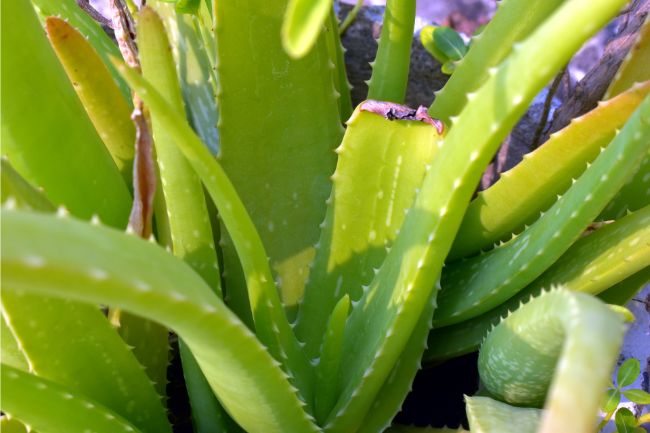
How To Keep Your Aloe Plant Happy And Healthy?
If you are still struggling with keeping your aloe plant happy and healthy, there are a few guidelines to remember to help it thrive.
- Plant your aloe in cactus and succulent soil in a pot with good drainage.
Remember that aloe vera plants like to dry out in between watering so they don’t have wet feet.
- Do not overwater your aloe plant; water thoroughly and deeply when the soil is dry.
Once you have watered your plant well, allow the excess water to drain off so the roots of the plant do not remain in soggy soil. Soggy soil and overwatering will cause root rot and plant death. Root rot is preventable if your soil conditions are right.
- Position your aloe plant where it gets bright, indirect light.
Too much direct sunlight will burn and potentially kill your aloe plant. If the window where you keep your aloe is too sunny, try moving it to a window on the opposite side of the house or moving it away from the window where it will get only indirect light.
- Keep your aloe plant comfortable.
Aloe plants prefer temperatures and humidity similar to what we naturally have in our homes, from 55-80°F with a humidity level of 40-50 percent. Too cold or too warm could send them into shock and do permanent damage to your plant.
- Don’t overfertilize your aloe plant.
Aloe plants don’t need much in the way of fertilizer. Give them half strength commercial succulent fertilizer once a year in the spring. This should be plenty of feeding to keep your plant healthy and growing.
If you start to see brown spots on your aloe plants, you’ll know what to do to figure out the problem and take the proper steps to correct it. Of course, the best medicine for your plants is good care and prevention. Prevent problems before they happen by taking excellent care of your aloe plant.

